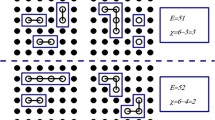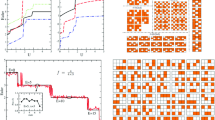Abstract
We analyze a quantum system of N identical spinless particles of mass m, in the lattice \(\mathbb {Z}^d\), given by a Hamiltonian \(H_N=T_N+V_N\), with kinetic energy \(T_N\ge 0\) and potential \(V_N=V_{N,2}+V_{N,3}\) composed of attractive pair and repulsive 3-body contact-potentials. This Hamiltonian is motivated by the desire to understand the stability of quantum field theories, with massive single particles and bound states in the energy-momentum spectrum, in terms of an approximate Hamiltonian for their N-particle sector. We determine the role of the potentials \(V_{N,2}\) and \(V_{N,3}\) on the physical stability of the system, such as to avoid a collapse of the N particles. Mathematically speaking, stability is associated with an N-linear lower bound for the infimum of the \(H_N\) spectrum, \(\underline{\sigma }(H_N)\ge -cN\), for \(c>0\) independent of N. For \(V_{N,3}=0\), \(H_N\) is unstable, and the system collapses. If \(V_{N,3}\not =0\), \(H_N\) is stable and, for strong enough repulsion, we obtain \(\underline{\sigma }(H_N)\ge -c' N\), where \(c'N\) is the energy of (N/2) isolated bound pairs. This result is physically expected. A much less trivial result is that, as N varies, we show \([\,\underline{\sigma }(V_N)/N\,]\) has qualitatively the same behavior as the well-known curve for minus the nuclear binding energy per nucleon. Moreover, it turns out that there exists a saturation value \(N_s\) of N at and above which the system presents a clustering: the N particles distributed in two fragments and, besides lattice translations of particle positions, there is an energy degeneracy of all two fragments with particle numbers \(N_r\) and \(N_s-N_r\), with \(N_r=1,\ldots ,N_s-1\).

Similar content being viewed by others
References
Lieb, E.H., Yngvanson, J.: Ground State Energy of the low density. Phys. Rev. Lett. 80, 2504–2507 (1998)
Asada, H., Futamase, T., Hogan, P.: Equations of Motion in General Relativity. Oxford University Press, New York (2010)
Spencer, T.: The decay of the Bethe-Salpeter kernel in \(P(\phi )_2\) quantum field models. Commun. Math. Phys. 44, 143–164 (1975)
Dimock, J., Eckmann, J.-P.: On the bound state in weakly coupled \(\lambda (\phi ^6-\phi ^4)_2\). Commun. Math. Phys. 51, 41–54 (1976)
Comberscure, M., Dunlop, F.: n-Particle-irreducible functions in Euclidean quantum field theory. Ann. Phys. 122, 102–150 (1979)
Koch, H.: Irreducible kernels and bound states in \(\lambda P(\varphi )_2\). Ann. Inst. Henri Poincaré A31, 173 (1979)
da Silva, Neves: R.: Three-particle bound states in even \(\lambda P(\phi )_2\). Helv. Phys. Acta 54, 131–190 (1981)
O’Carroll, M., Faria da Veiga, P.A., Francisco Neto, A.: Analytic binding energies for two-baryon bound states in 2 + 1 strongly coupled lattice QCD with two-flavors. Commun. Math. Phys. 321, 249–282 (2013)
Faria da Veiga, P.A., O’Carroll, M.: Eightfold way from dynamical first principles in strongly coupled lattice quantum chromodynamics. J. Math. Phys. 49, 042303 (2008)
Glimm, J., Jaffe, A.: Quantum Physics: A Functional Integral Point of View. Springer, New York (1986)
McGuire, J.B.: Study of exactly soluble one-dimensional N-body problems. J. Math. Phys. 5, 622–636 (1964)
Ruelle, D.: Statistical Mechanics: Rigorous Results. W.A. Benjamin, New York (1969)
Simon, B.: The \(P(\phi )_2\) Euclidean (Quantum) Field Theory. Princeton University Press, Princeton (1974)
Reed, M., Simon, B.: Modern Methods of Mathematical Physics, vol. 2. Academic Press, London (1975)
Machleidt, R., Entem, D.R.: Towards a consistent approach to nuclear structure: EFT of two- and many-body forces. J. Phys. G31, S1235–S1244 (2005)
Machleidt, R., Entem, D.R.: Chiral effective field theory and nuclear forces. Phys. Rep. 503, 1–75 (2011)
Gueorguiev, V.G., Navrátil, P., Vary, J.P., Draayer, J.P., Pan, F.: arXiv:1011.5947v1 (2010)
Binder, S., Langhammer, J., Calci, A., Navrátil, P., Roth, R.: Ab initio calculations of medium-mass nuclei with explicit chiral 3N interactions. Phys. Rev. C 87, 021303(R) (2013)
Creutz, M.: Quarks, Gluons and Lattices. Cambridge University Press, Cambridge (1983)
Montvay, I., Münster, G.: Quantum Fields on a Lattice. Cambridge University Press, Cambridge (1997)
Gattringer, C., Lang, C.B.: Quantum Chromodynamics on the Lattice: An Introductory Presentation. Springer, New York (2009)
Acknowledgments
This work was partially supported by CNPq.
Author information
Authors and Affiliations
Corresponding author
Rights and permissions
About this article
Cite this article
Faria da Veiga, P.A., O’Carroll, M. Stability and Clustering for Lattice Many-Body Quantum Hamiltonians with Multiparticle Potentials. J Stat Phys 161, 712–720 (2015). https://doi.org/10.1007/s10955-015-1343-5
Received:
Accepted:
Published:
Issue Date:
DOI: https://doi.org/10.1007/s10955-015-1343-5




